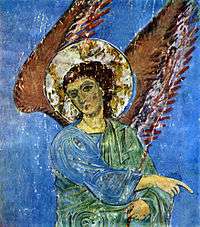Kintsvisi Monastery
| Kintsvisi Monastery ყინწვისის მონასტერი (Georgian) | |
|---|---|
|
| |
| Basic information | |
| Location |
Kintsvisi, Shida Kartli Province (Mkhare), |
| Geographic coordinates | 41°34′26″N 43°30′05″E / 41.5738°N 43.5014°ECoordinates: 41°34′26″N 43°30′05″E / 41.5738°N 43.5014°E |
| Affiliation | Georgian Orthodox |
| Architectural description | |
| Architectural type | Church |
| Completed | 13th century |
Kintsvisi Monastery (Georgian: ყინწვისი, Qinc'visi) is a Georgian Orthodox monastery in the Shida Kartli region, eastern Georgia, 10 kilometers from the town Kareli, on a forested slope of a high mountain of the Dzama valley.
History
The Kintsvisi Monastery complex consists of three churches, of uncertain origin. The central (main) central church dedicated to St Nicholas is thought to date to the early 13th century, in what is generally regarded as the Georgian Golden Age. A very small chapel standing next to it is dedicated to St George, and dates from around the same time.
The oldest church, dedicated to St Mary dates from the 10-11th centuries, but is mostly in ruins.
The site is currently listed by the World Monuments Fund as a field project.
Architecture

The main church is a large inscribed-cross domed brick building which houses unique examples of medieval mural art from the early 13th century.
In the central position of the cupola is the Hodegetria flanked by the archangels Michael and Gabriel. At the central part of cupola arch is an expressed cross as a medallion. Medallions with the Four Evangelists adorn the pendentives. Images of archangels are repeated on south and west walls of the church. Scenes from the New Testament are presented on north walls, as are portraits of Georgian kings, Giorgi III, Tamar and Giorgi IV Lasha. Particularly remarkable is the figure of a sitting angel (the so-called “Kintsvisi Archangel”) from the Resurrection composition pointing at the open sarcophagus in a gracious manner, represented above the kings' figures, between two windows. These murals date to before 1205 and rank, due to the lavish use of lapis-lazuli to color their backgrounds, among the most beautiful paintings of that period.
These murals were ordered by Anton Gnolistavisdze, a local feudal magnate who served as a royal minister. His fresco with a model of a church in his hand is represented on the lower register of the south wall, along with a severely damaged cycle of images from the life of St Nicholas, and depictions of various Georgian saints.
The murals of the narthex are of a later date, and were painted by the order of a prominent person of the 15th century, Zaza Panaskerteli, whose portrait is represented here as well.
The church of the Virgin Mary also contains an enthroned Hodegetria with a Communion of the Apostles in its ruined apse. The walls of this church were presumably entirely painted in the same manner as the main church, but everything but the apse has collapsed into ruins down the side of the mountain.
References
- Abashidze, Irakli. Ed. Georgian Encyclopedia. Vol. IX. Tbilisi, Georgia: 1985.
- Amiranashvili, Shalva. History of Georgian Art. Khelovneba: Tbilisi, Georgia: 1961.
- Rosen, Roger. Georgia: A Sovereign Country of the Caucasus. Odyssey Publications: Hong Kong, 1999. ISBN 962-217-748-4
External links
| Wikimedia Commons has media related to Kintsvisi Monastery. |